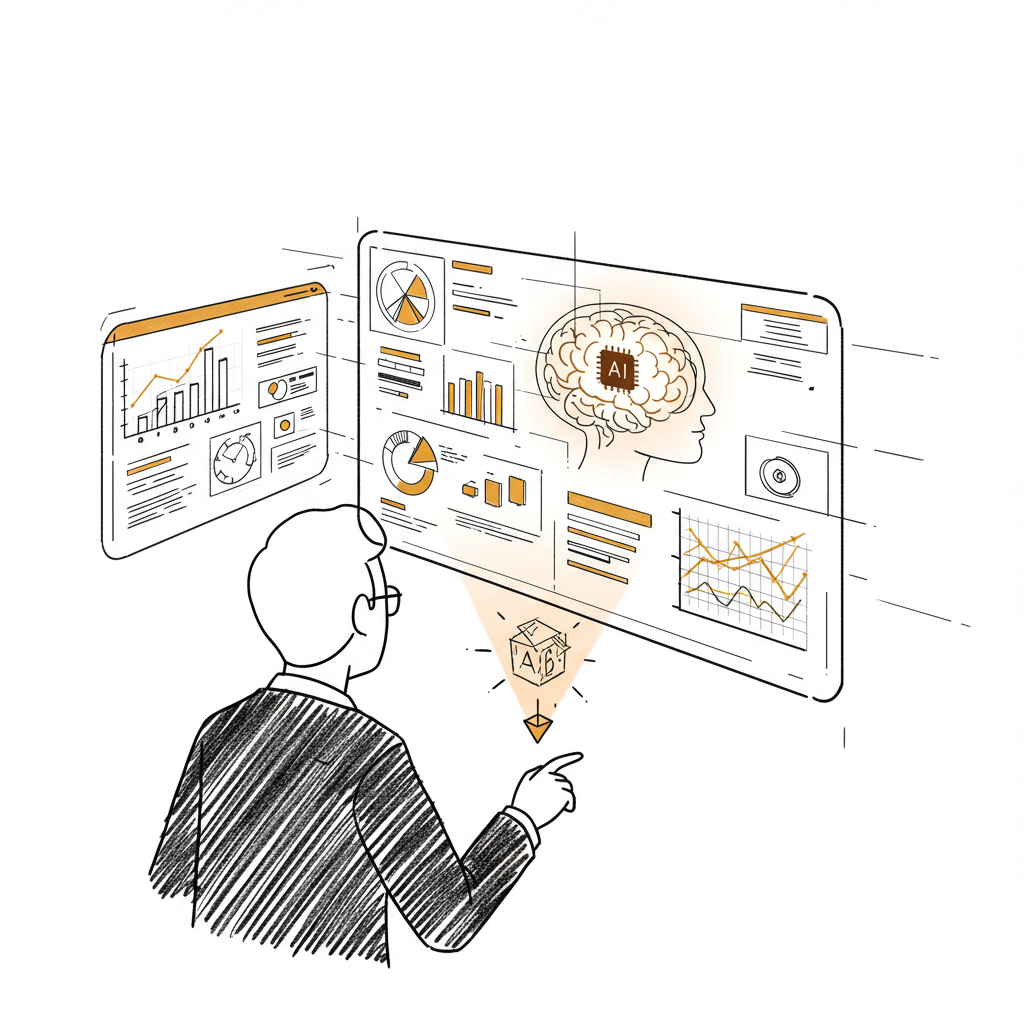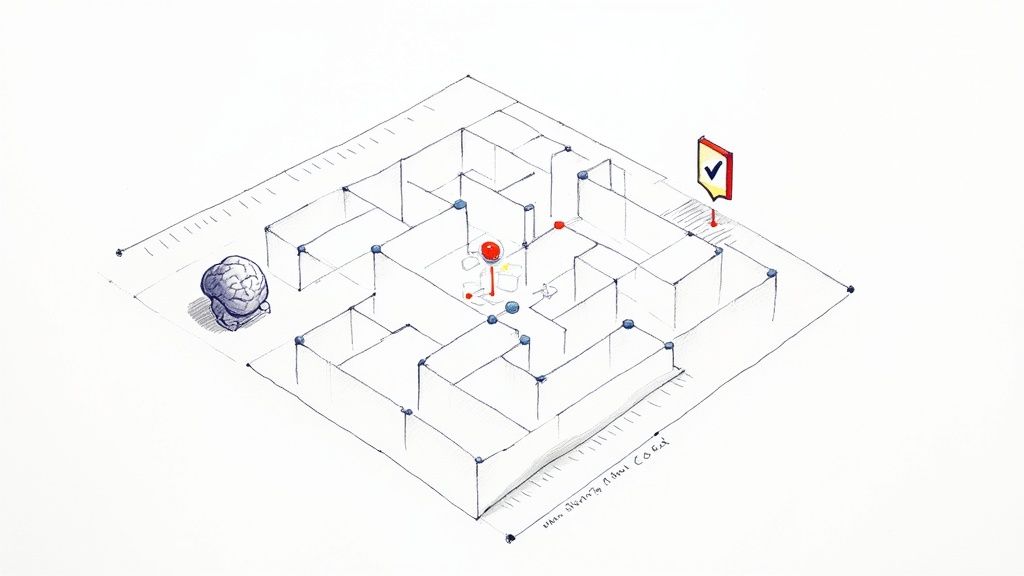Unlock Growth with Industry-Specific AI Solutions
Discover how industry-specific AI solutions can transform your business. Get tailored strategies for finance, healthcare, and manufacturing now!
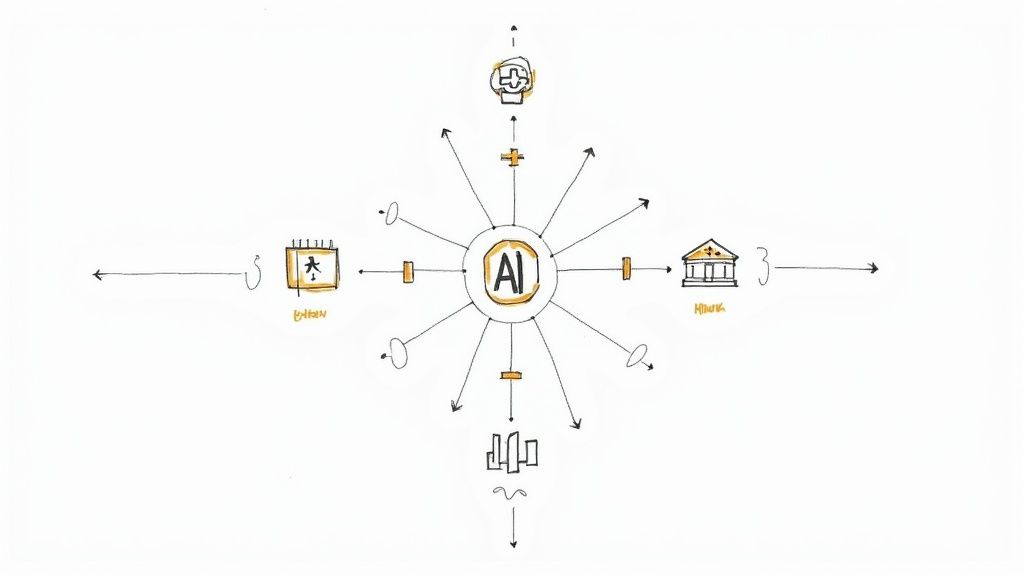
Think of it this way: you wouldn't use a kitchen knife for surgery, would you? Both can cut, but only a scalpel has the specific design and precision for the job. That's the core difference between a general-purpose AI and an industry-specific AI solution.
General AI tools are fantastic all-rounders. But for the nuanced, high-stakes problems found in specific sectors, you need a tool built with deep domain knowledge and trained on highly specialized data.
Why Off-The-Shelf AI Just Doesn't Cut It
In the fast-moving world of artificial intelligence, a one-size-fits-all model rarely delivers the best results. General AI models are great for broad tasks like summarizing an article or creating a stock image, but they completely miss the mark in complex, regulated fields.
These systems simply aren't trained on the unique jargon, strict compliance rules, or intricate operational workflows that are the bread and butter of industries like finance, healthcare, or manufacturing.
This is precisely where industry-specific AI shines. Instead of a generic tool, you get a solution that speaks your business’s language from day one. This targeted approach leads to a much higher return on investment, drives real efficiency gains, and builds a genuine competitive advantage. Getting there often involves a process of AI co creation, where deep business insight and technical expertise come together to build something truly powerful.
The Strategic Value of Specialization
Shifting toward specialized AI isn't just a fleeting trend; it’s a strategic imperative. The global artificial intelligence market is on a massive growth trajectory, expected to climb from an estimated $294.16 billion in 2025 to an incredible $1,771.62 billion by 2032.
This explosion shows AI's immense potential to reshape how industries operate. To actually capture that value, businesses have to move beyond generic tools. You can discover more insights about this explosive market growth and what it means for your sector.

The real power of AI is unlocked when it’s fine-tuned to solve specific, high-value problems within a given industry. It’s about moving from broad capabilities to precise, outcome-driven results.
Making this shift requires a solid plan, which is why effective AI strategy consulting is so important. It helps connect what's technologically possible with what your business actually needs to achieve. A thoughtful strategy ensures you’re not just chasing new tech but building a system that solves real-world problems and gives you a lasting edge.
For any business ready to start this journey, a detailed Custom AI Strategy report can provide the roadmap needed to navigate the complexities and make it happen.
To make the distinction clearer, let's break down the key differences between these two approaches.
General AI vs. Industry-Specific AI at a Glance
This table offers a quick comparison, highlighting how general-purpose and industry-specific AIs differ in everything from data and training to their ultimate business impact.
| Feature | General-Purpose AI | Industry-Specific AI |
|---|---|---|
| Data Source | Trained on vast, public internet data (e.g., Wikipedia, common websites). | Trained on curated, high-quality, domain-specific datasets (e.g., medical journals, financial records, engineering schematics). |
| Core Function | Performs a wide range of tasks reasonably well (e.g., writing, translation, image generation). | Excels at a narrow set of highly specialized tasks (e.g., fraud detection, medical imaging analysis, predictive maintenance). |
| Accuracy | Generally good, but can make errors on niche or technical topics. | Extremely high accuracy and reliability within its designated field. |
| Compliance | Not inherently built for regulatory compliance (e.g., HIPAA, GDPR). | Designed from the ground up to meet strict industry regulations and data privacy standards. |
| Implementation | Quick to deploy for common use cases; "plug and play." | Requires deeper integration with existing business systems and workflows. |
| Return on Investment (ROI) | Delivers productivity gains on general tasks. | Drives significant ROI by solving core, high-value business challenges. |
As you can see, while general AI is a great starting point, the real, game-changing value comes from solutions built for the specific world you operate in.
How Tailored AI Is Making Its Mark in Key Industries
The idea of specialized AI really clicks when you see it in the wild. Moving from theory to practice, industry-specific AI solutions are already creating real, measurable value in some of the world's most complex fields. We're not talking about generic chatbots or simple automation tools here. These are highly focused systems designed to tackle deep-rooted industry problems with surgical precision.
Let's dig into how this targeted approach is making a difference in finance, healthcare, and manufacturing. Each area has its own unique set of challenges, and each one shows the power of AI that truly "speaks the language" of the industry.

Financial Services AI: Securing the Digital Economy
The world of finance is all high stakes and massive amounts of data, making it a perfect testing ground for specialized AI. It’s no surprise that the average return on investment for generative AI projects in finance is 4.2 times—the highest of any industry. The impact is immediate and significant.
Fraud detection is a fantastic example. Old-school systems rely on fixed rules that criminals quickly figure out how to game. An industry-specific AI, on the other hand, can sift through millions of transactions in real-time, catching subtle, shifting patterns of fraud that a human would never spot. This isn't just about blocking a stolen credit card; it's about getting ahead of sophisticated, coordinated attacks before they do major damage.
Beyond security, AI is also changing how banks and customers interact. To see just how deep this change goes, check out some of these powerful chatbot use cases that show how AI is overhauling business operations everywhere. Instead of clunky FAQ bots, financial firms are using smart assistants that can tackle complex questions, offer personalized investment ideas, and walk users through loan applications, all while staying on the right side of strict regulations.
Healthcare AI: A New Era for Diagnostics and Patient Care
In healthcare, there's zero room for error. Precision is everything. This is where specialized AI models, trained on huge archives of medical data, are becoming essential partners for clinicians. They aren't replacing doctors; they're amplifying their skills and leading to better outcomes for patients.
Take medical imaging. An AI algorithm trained specifically on radiological scans can spot tiny anomalies, like the earliest signs of a tumor, that the human eye might miss in a routine check. By flagging these potential trouble spots, the AI acts as a second pair of expert eyes, which can lead to a much earlier diagnosis and more effective treatment.
This idea of personalization also applies to treatment planning. AI systems can chew through a patient's genetic profile, medical history, and lifestyle data to predict how they might respond to different drugs or therapies. This helps doctors design incredibly customized treatment plans, shifting the entire field away from a one-size-fits-all model toward true precision medicine.
Manufacturing AI: Building Smarter Factories
A factory floor is a buzzing ecosystem of machines, supply chains, and people. Success is measured in efficiency and uptime. Industry-specific AI is becoming a must-have for fine-tuning these complex operations, with manufacturers reporting a 3.4 times ROI on their generative AI investments.
Predictive maintenance is a real game-changer. AI models listen to the data streaming from industrial equipment—vibrations, temperature, output—to predict when a machine is about to fail. This gives maintenance crews a heads-up to schedule repairs before a breakdown grinds everything to a halt, saving companies a fortune in unplanned downtime and making expensive equipment last longer.
But it doesn't stop there. AI is optimizing the entire production line.
- Quality Control: AI-powered cameras can spot microscopic defects on an assembly line faster and more accurately than any human inspector.
- Supply Chain Optimization: AI algorithms analyze everything from demand forecasts to supplier reliability to make sure parts and materials show up exactly when needed, slashing waste and storage costs.
- Generative Design: Engineers can now use AI to explore thousands of potential product designs based on specific constraints like weight or material strength, radically speeding up innovation.
Each of these examples points to the same core idea: the most powerful AI is built for a specific job. By understanding the unique DNA of an industry, these specialized solutions deliver results that generic, off-the-shelf tools just can't touch. For many organizations, bringing in a customizable AI assistant is the first step toward building these potent, sector-specific capabilities.
How Custom AI Gives You a Real Competitive Edge
Let's be honest: the true power of industry-specific AI isn't just about speed. It’s about being smarter in a way your competition can't just copy and paste. Off-the-shelf AI tools are great for a quick productivity bump, but they put everyone on the same level playing field. A real, lasting advantage comes from building something that’s a perfect fit for your business and no one else's.
This is where your own data becomes your secret weapon. General AI models learn from public information, but an industry-specific AI solution built just for you learns from your data—your customer service logs, your supply chain quirks, your internal R&D. That’s how you build a competitive moat that's genuinely defensible.
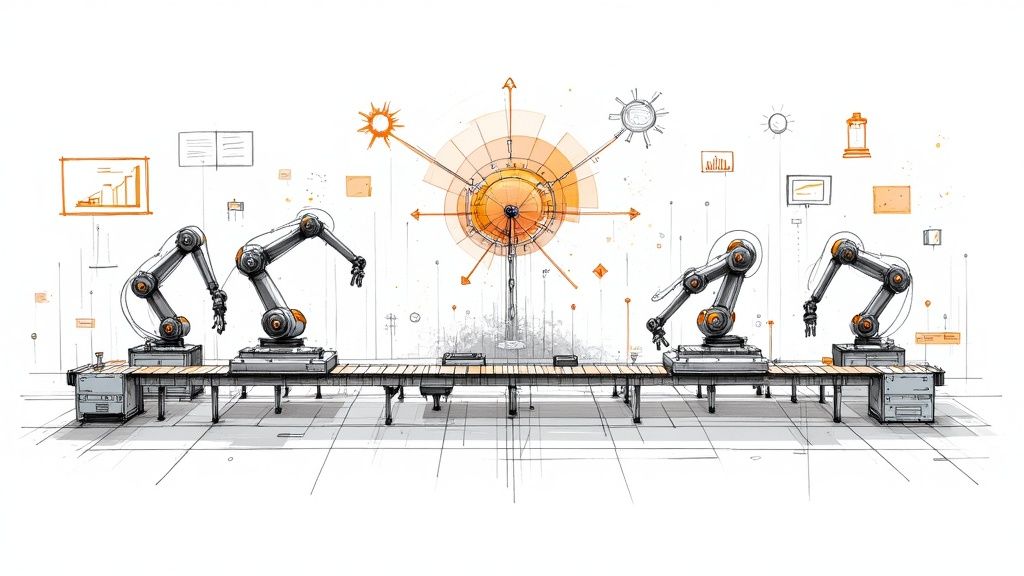
Suddenly, your unique business history becomes an asset no competitor can buy or replicate. Of course, aligning this kind of powerful tech with your actual business goals is where you need a solid game plan, which is why AI strategy consulting is so important.
Turning Your Data into a Strategic Weapon
Think of your business as its own little ecosystem. It has unique rules, workflows, and customer behaviors. A custom AI gets to know the ins and outs of that specific ecosystem. It doesn't just get your industry; it gets your company within that industry.
This deep, focused understanding opens up some serious advantages:
- Next-Level Personalization: Forget basic customer segments. A custom AI can start predicting what individual customers need before they even know it, leading to hyper-personalized experiences that build fierce loyalty.
- True Operational Excellence: The system can spot tiny inefficiencies in your specific processes that a generic tool would never see, recommending tweaks that go straight to your bottom line.
- Proactive Decision-Making: Instead of just reacting to what the market does, your AI can forecast trends using your own historical data. This gives you the heads-up to make a move before anyone else does.
We're seeing this play out in a big way in manufacturing. The AI market in that sector alone was valued at roughly $1.4 billion back in 2020 and is on track to hit a massive $14.3 billion by 2027. More importantly, companies putting AI to work are already outperforming their peers by about 12%. It’s hard to argue with those numbers. You can discover more about these AI adoption trends to see how deeply this is reshaping industries.
Sharpening High-Stakes Decision-Making
Every business leader has to make tough calls with a lot on the line. A custom AI acts as an incredibly powerful analytical partner, finding clarity in massive, messy datasets. It can run thousands of simulations, model different outcomes, and flag risks that a human analyst might completely miss.
By turning your raw, proprietary data into clear, actionable intelligence, custom AI gives leaders the confidence to make the bold, informed moves that separate the followers from the market leaders.
This goes way beyond simple dashboards. We're talking about a dynamic system that can answer complex "what-if" questions on the fly. This is a game-changer for everything from long-term strategic planning to navigating a sudden supply chain crisis. The insights you get aren't generic; they’re grounded in the reality of how your business actually operates.
Ultimately, this is what fuels real innovation. By finding hidden patterns and unmet needs buried in your own data, a custom AI can spark ideas for new products, services, and revenue streams you never would have thought of. That cycle of innovation, born from a deep understanding of your own data, is the ultimate competitive advantage.
Your Practical Framework for AI Adoption
So, how do you go from recognizing the power of industry-specific AI to actually making it work for your business? You need a plan. Without a solid framework, even the most exciting AI idea can get stuck in the pilot phase, becoming a pricey experiment instead of a genuine asset.
This roadmap breaks the whole process down into four straightforward stages. Think of it as your guide to turning a great concept into real-world impact.
Stage 1: Discovery and Strategy Definition
Before anyone writes a single line of code, you have to get laser-focused on the exact business problem you’re solving. Are you trying to cut down on machine downtime on the factory floor? Do you need to automate tedious compliance checks in your finance department? Or is the goal to create hyper-personalized outreach for patients?
Vague ambitions like "we want to use AI" are a fast track to nowhere. You need specific, measurable goals. This stage is all about digging into your current workflows to find the real pain points. It’s about translating your business needs into a technical blueprint—a process that ensures the final product is exactly what you need. Think of it as drawing up the architectural plans before you even think about pouring the foundation.
Stage 2: Data Readiness and Infrastructure Assessment
Here’s a hard truth: AI is only as smart as the data it’s fed. This second stage is where you take a long, honest look at your data. You need to figure out the quality, quantity, and accessibility of what you have. Is your data clean, organized, and ready to go, or is it a tangled mess spread across old, disconnected systems?
If your data isn't in shape, your AI project will hit a wall. This phase typically involves:
- Data Audits: Finding and mapping out all your relevant data sources.
- Cleaning and Preprocessing: Fixing errors, getting rid of duplicates, and putting everything into a standard format.
- Infrastructure Review: Making sure your current IT setup can handle the heavy lifting required for AI model training and deployment.
Nailing this stage ensures your AI model is built on a foundation of solid, high-quality information. That's the only way to get results you can actually trust.
Stage 3: Development and Seamless Integration
Once you have a clear strategy and clean data, it's time for the fun part: development. This is where data scientists and engineers get to work building, training, and testing the AI models. The focus isn't just on building something that works in a sterile lab environment; it has to work flawlessly within your team's day-to-day reality.
Integration is everything. You can have the most powerful AI tool in the world, but if your employees find it clunky or difficult to use, it's basically worthless. That’s why the design needs to be intuitive, plugging right into the software your team already uses. The goal is to make the AI feel like a natural helper, not another complicated system to learn from scratch. Getting this right is a specialized skill, and exploring your options for AI implementation support can be a game-changer.
This infographic lays out the typical journey from the initial analysis all the way to performance monitoring.
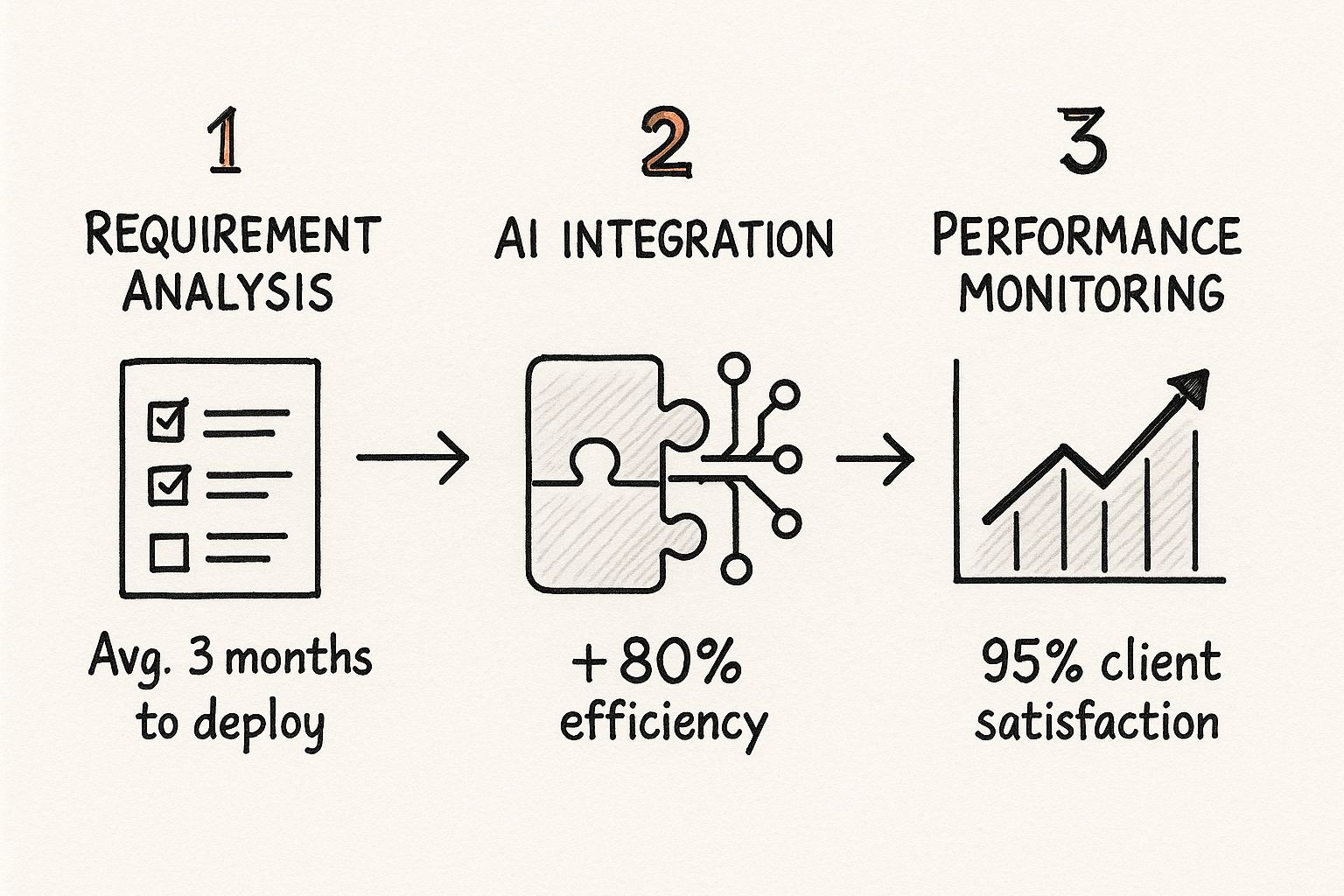
As you can see, a well-planned project can move from requirements to deployment in about three months, which is a pretty fast track to major efficiency boosts and happier users.
Stage 4: Monitoring and Continuous Optimization
Getting your AI solution live isn't the end of the road—it’s just the beginning. The final stage is all about continuous monitoring, scaling, and fine-tuning. AI models aren't "set it and forget it." Their performance can degrade over time as new data flows in and market conditions shift.
Think of your AI as a living system. It needs to be looked after so it can adapt and evolve. Constant monitoring is the only way to ensure your solution stays accurate, effective, and aligned with your business goals.
This means keeping a close eye on key performance indicators (KPIs), listening to user feedback, and periodically retraining the model with fresh data to keep it sharp. By treating AI as an ongoing capability rather than a one-off project, you build a dynamic asset that keeps getting better and delivering more value over the long haul.
Overcoming Common AI Implementation Hurdles
Let’s be honest: jumping into AI isn't always a walk in the park. Adopting powerful industry-specific AI solutions is more than a tech upgrade; it's a major business move. But with the right mindset and a bit of foresight, the common roadblocks are completely avoidable.
The trick is to treat it like any other major initiative and focus on mastering software project risk management. When you can see the potential issues with data, skills, and system integration coming, you’re already halfway to a successful rollout.
Navigating Data Privacy and Security
In heavily regulated industries like finance and healthcare, your data is both a goldmine and a massive liability. You simply can't deploy an AI solution without an airtight plan for data governance. Customers, partners, and regulators all need to know that you're handling sensitive information correctly.
This means privacy and security can't be an afterthought—they have to be baked into the system from the very beginning. Key practices include:
- Data Anonymization: This involves scrubbing all personally identifiable information (PII) from your datasets before your AI models ever see them.
- Access Control: Lock it down. Implement strict, role-based permissions so that only the right people can access sensitive data.
- Compliance by Design: Build your system to automatically follow regulations like GDPR or HIPAA. This takes the guesswork out of compliance and minimizes the chance of human error.
When you make data protection a core tenet of your strategy, you're not just avoiding fines; you're building trust. And as we've covered before, that trust is the real foundation for success.
Bridging the Internal Skills Gap
You can have the most brilliant AI strategy on paper, but it means nothing without the right team to bring it to life. One of the most common hurdles is the internal skills gap—that chasm between the talent you have on board and the expertise you actually need.
Don't assume you need to clean house and hire a brand-new team. A smarter approach is to upskill your current people while bringing in outside experts for specialized tasks.
Invest in your existing team. Training them on AI fundamentals and improving data literacy across the board helps create an innovative culture from the ground up. For the really complex stuff, find partners who live and breathe industry-specific AI solutions. This hybrid model gives you access to top-tier knowledge without getting bogged down in a long, expensive hiring cycle.
Integrating AI with Legacy Systems
Very few companies get to start from scratch. Your shiny new AI tools have to play nice with the legacy systems you've relied on for years. If you don't plan the integration carefully, you can cause massive disruptions and create a bigger mess than you started with.
The secret is to take it one step at a time. Start with a small pilot project to prove the concept and iron out the integration wrinkles on a limited scale. This helps you show a quick return on investment and builds the confidence needed for a wider implementation. A detailed AI requirements analysis is non-negotiable here; it’s your roadmap for connecting the new tech to your existing stack.
By getting ahead of these common challenges—data security, skill shortages, and technical integration—you can create an AI adoption plan that's built to last. We know it can be a lot to juggle, and that's where having an experienced guide makes a world of difference. Our expert team is ready to help you navigate the complexities and fast-track your path to success.
Where Industry-Specific AI Is Headed Next
If you think today's AI is impressive, just wait. We're on the cusp of a major shift, moving far beyond basic automation. The next generation of industry AI won't just follow instructions; it will anticipate needs, generate novel solutions, and even collaborate with human experts. Getting a handle on these trends is crucial for anyone building a business strategy that's meant to last.
One of the most exciting frontiers is hyper-personalization. This isn't just about segmenting customers into broad groups. We're talking about AI that crafts a completely unique experience for every single person. Imagine a healthcare AI that analyzes your real-time health data to suggest preventative actions, or an e-commerce platform that designs a one-of-a-kind shopping journey the moment you land on the site.
Generative and Explainable AI are Changing the Game
Generative AI is also outgrowing its current role as a content creator. Its real future is in tackling complex, creative problem-solving. We're not far from systems that can generate brand-new engineering designs, dream up new chemical compounds for medicine, or architect sophisticated financial models from scratch. This jump from creating content to driving genuine innovation will completely reshape technical fields, putting processes like AI co creation at the heart of how we work. To see where this is all starting from, you can check out our collection of real-world use cases that are laying the groundwork today.
But as AI gets smarter and more independent, we run into a big question: can we trust it? That’s where Explainable AI (XAI) comes in.
Explainable AI is all about cracking open the AI "black box" so we can understand its reasoning. In high-stakes fields like finance or healthcare, you can't afford to just trust a recommendation without knowing why the AI made it. It’s a matter of compliance, managing risk, and earning trust. Soon, XAI won't be a nice-to-have feature; it will be a requirement.
Getting ready for this future means you can't sit back and wait. A solid AI Strategy consulting tool can help you see where these trends are going and figure out where to place your bets. The companies that will win in the long run aren't just adopting AI—they're building a culture that's ready for its next evolution. If you need help building that forward-looking roadmap, our expert team is here to help.
Common Questions About Industry-Specific AI
We get asked a lot about how to get started with AI that’s built specifically for a certain industry. Here are a few of the most common questions we hear, along with some straightforward answers to get you pointed in the right direction. For an even deeper dive, feel free to check out our complete AI FAQ page.
So, Where Do We Even Start?
This might surprise you, but the best place to start isn't with the technology—it's with your strategy. First, pinpoint a single, high-impact business problem you're trying to solve. What's a nagging issue that, if fixed, would make a real difference?
Once you have that, define what success actually looks like in concrete terms. This means doing a proper AI requirements analysis to map out your specific needs and taking an honest look at your data. In most cases, kicking things off with a small, focused pilot project is the smartest move to show value quickly and build momentum.
How Much Data Do We Really Need?
There's no single answer to this one. The amount of data you need really depends on how complex your problem is. But here’s the most important thing to remember: data quality is far more important than sheer quantity. Your data has to be clean, relevant to the problem, and well-organized.
A data audit, which is usually part of an initial AI strategy consulting phase, will tell you if what you have is good enough to get started. If it isn't, the audit gives you a clear roadmap for collecting the right kind of information before you move forward.
An AI project's success doesn't ride on having massive datasets. It rides on having the right dataset. High-quality, industry-specific data is the fuel that powers accurate and reliable models.
Can a Smaller Business Actually Afford a Custom AI Solution?
Yes, absolutely. Custom-built AI isn't just for the big players anymore. Today, many AI platforms and specialized vendors offer solutions that can scale up or down, making them a great fit for small and medium-sized businesses.
The trick is to zero in on use cases that deliver a high return on investment, like automating repetitive manual tasks or giving your customer service a boost. A solid strategy ensures that even a smaller investment can create significant value, a point we also touched on in our AI adoption guide. This approach puts powerful technology within reach for businesses of any size.
Ready to build an AI strategy that delivers real business impact? At Ekipa AI, we help you identify and execute high-value AI opportunities in just 24 hours. Start building your custom AI roadmap today at https://www.ekipa.ai. For a deeper look at the expertise driving our solutions, meet our expert team.


